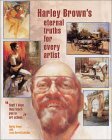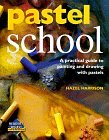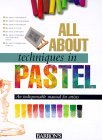The Classroom
Book Reviews: Soft Pastel
 |
Title: Harley Brown's Eternal Truths for Every Artist |
Harley Brown has combined his 50 years of work and teaching experience to create an inspirational training manual for artists. There are no slick methods, easy tricks, or how-tos to be found in this book. You'll work from life, and apply the information you've learned into your own work. This book was my first introduction to the Munsell color wheel.
Chapter 1: Before We Begin
General advice about becoming an artist.Chapter 2: Contrary To What You May Have Heard...
The importance of drawing accuracy; learn to measure. A seated ballerina is demonstrated.Chapter 3: What Every Artist Should Do First
Blank paper intimidation and how to overcome it.Chapter 4: Forget Color For a Moment
The importance of understanding values; shadows.Chapter 5: Composition - Who Needs it?
You do. It's more important than content. Discusses shapes, direct light, reflected light, unequal lighting, and blocking in. Demonstration of a statue.Chapter 6: All About Edges
Lost, found, and shadow edges. How to convey distance. A monochromatic exercise of Harley's dog is included.Chapter 7: Working With Color
An introduction to the Munsell color wheel. Dominant, complementary, and discord colors. Demonstrations include Fiji Man, Harley's Harley, and El Grande, a large Mexican gate.Chapter 8: Build Excitement in Your Paintings
Dramatic lighting, use of diagonals. Includes demos of a female nude, and a portrait.Chapter 9: Breathing Life into Your Paintings
Working with a model and tips for working from photos. General facial features, center of interest, composing the picture, and things to leave out are also covered.Chapter 10: Knowing When to Stop
A detached eye is a better for this.Chapter 11: Going On From Here
Figure drawing, hiring a model, and taking the Harley Oath.Chapter 12: Establishing Your Workspace
A clean studio is a productive one. Harley shares his favorite tools, and ideas for your own studio.
Harley Brown works from life, and the book contains several images of his own works in progress which you're encouraged to try. This is not a how-to book for the beginners, and there are no step-by-step projects to work through. Some drawing experience is assumed as the methods are true to studio life drawing. Harley prefers soft pastel, uses oils on occasion, and offers good, solid advice for artists working in any medium. He's confident, opinionated, a little bit sarcastic, and I really enjoyed this book.
 |
Title: Pastel School |
I like this book. Simple excercises introduce beginners to making their first marks on the paper and continue into some fairly detailed projects using various supports. The chapter two sampler is easy enough that I would be comfortable giving this book to an 8 or 9-year-old child. The eight projects in chapter five are fairly complex compositions. You'll be doing your own drawing, with color guidance provided beneath the in-progress images to help you understand how the pastel is being developed.
Introduction: A short, but wonderful overview of the many methods of application and the resulting artwork.
Chapter 1: What You Will Need
A good overview of different types of pastels and supports. A recommended starter palette is included, as well as some of the tools found in a pastellist's studio.Chapter 2: First Marks
Draw a few lines and make a few side strokes. Then make yourself a nifty sampler to hang in your studio. A simple exercise anybody can play with.Chapter 3: Building Up Your Skills
Learn about cross-hatching, broken color, blending, and layering. A still life rendering by two different artists compares the different methods.Chapter 4: Basics of Picture Making
Starts with some basics about composition and then discusses how to go about creating one. Methods discussed are working from life, working from sketches, and working from photos. Basic information about color. Includes an interesting comparison of two landscapes done by the same artist.Chapter 5: Picture Making
Eight different projects allow the beginner to create a completed pastel.
Project 1: Still Life on Pastel Board
Project 2: Interior on Canson Mi-Teintes - rough side
Project 3: Floral on Canson Mi-Teintes - smooth side - uses vine charcoal
Project 4: Seascape on Sanded paper - unnamed tinted paper, probably La Carte
Project 5: Landscape on Canson Mi-Teintes - smooth side
Project 6: Portrait on Canson Mi-Teintes - smooth side
Project 7: Figures in the Landscape - unnamed paper, demo includes pencil and black conte crayon.
Project 8: Buildings - unnamed paper, uses masking tape to create a sharp edge.
This book covers everything from the most simple exercises to creating a complex scene. Some notable names in the pastel world with examples in this book include Bob Rohm, Kitty Wallis, Jackie Simmonds, Doug Dawson, Sandra Burshell, Margaret Glass, Alan Oliver, Rosalie Nadeau, and many more. The included artwork has also been done on a variety of supports that include board, sanded and watercolor papers, and tinted art papers such as Canson.
What I really like about this book is the diversity of techniques and materials. The examples presented from the masters of this medium show off their versatility. This book offers lots of creative options for the aspiring artist.
Note: The author uses Daler Rowney pastels. A starter palette is given in Chapter One, with additional colors added in later chapters. Corresponding colors for Rembrandt and Grumbacher pastels are included at the back of the book. Any of these brands is a good choice, but since this book was first published, Daler-Rowney has revised their pastel line, and Grumbacher is now made by Sanford.
 |
Title: All About Techniques in Pastel |
Another good choice for the beginner, this book offers unique exercises for objects found in artwork in addition to complete scenes. This book includes figures, animals, trees, water, and sky variations. Learn how to do them, and then combine what you've learned to create your own pastel artwork.
This book doesn't feature the work of prominant artists, and appears to be done by one person. The example artwork is relatively simple and somewhat generic, but there's a lot of it. The artist works from reference photographs, and doing the same can help develop your own style. It won't take much imagination or skill to alter the examples on your own.
Materials and Equipment
Presents the types of pastels available, unique ideas for supports, easels, boards and storage boxes.
Pastel Techniques
Demos in this section:
One color: Still Life with Pumpkin uses dark red pastel on cream colored paper.
Two color: Jug of Milk is rendered with dark gray and pale yellow.
Three color: Still Life with Onions using dark green, medium yellow and red.
Background color: Various background colors beneath a blue parakeet.
Light and Shadow: Frontal, overhead, and backlighting exercise using a seashell.
Methods: Floral still life.
Painting with Lines: Saguaro cactus under a blue sky.
True Painting: Thick layers of pastel called impasto create Still Life with Tomatoes.
Blending: A very simple floral.
Painting with Short Strokes: Create fish scales on three salmon.
Painting with Water: A group of brightly colored hand-held fans.
Oil Pastel: A rooftop cityscape.
Pastel Subjects
The best part of the book.
Skies: Clear blue sky, fog, cloud formations, and a nighttime electrical storm.
Water: Reflections, surface movement, waterfalls, waves, and seafoam.
Vegetation: Palm, pine, balsa, and lemon trees, grasses, meadows and fields. Flowers include an amaryllis, dahlias. Create a Van Gogh still life with sunflowers.
Fruits: Watermelon, citrus fruits, and cherries.
Figures: Wet kids at the beach, delicate female shoulders, wrinkled hands, and a life drawing exercise using a nude female model.
Portraits: A child with a teddy bear, the old man of the sea, and a woman from India.
Clothed Figures: Wet shirt, monk's robe, blue jeans, leggings, and a baggy shirt.
Animals: Snake, cow, cat, parrot, owl, chimpanzee, and a couple of porpoise.
Drapery: Folds, wrinkles, and gauze. Create a Degas ballerina.
Metal and Glass: Motorcycle headlight.
Note: There are several tree demonstrations where the artist uses black pastel. For these exercises I would recommend using one of Sennelier's black greens instead. I also prefer alcohol to water because it evaporates faster, and causes less buckling to the paper.